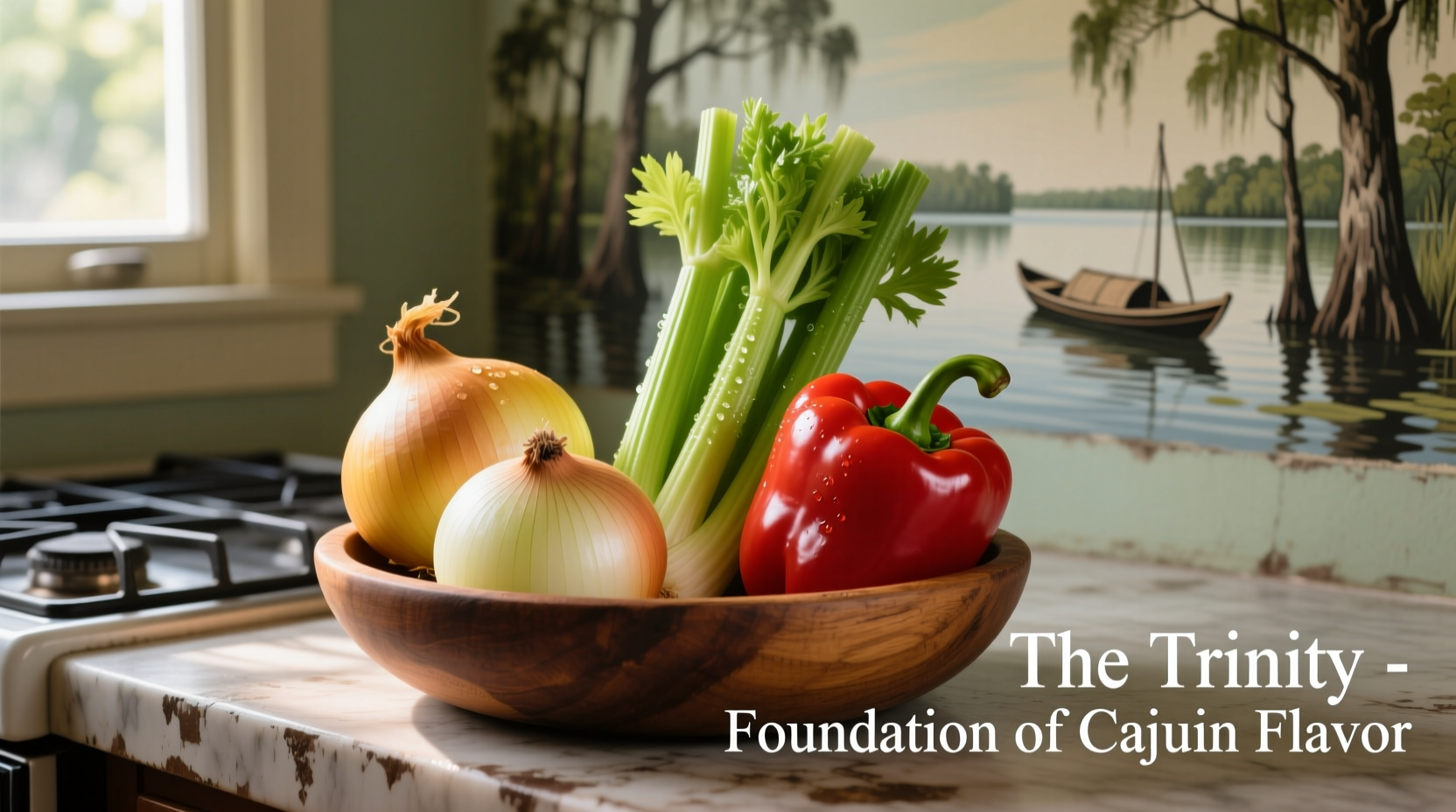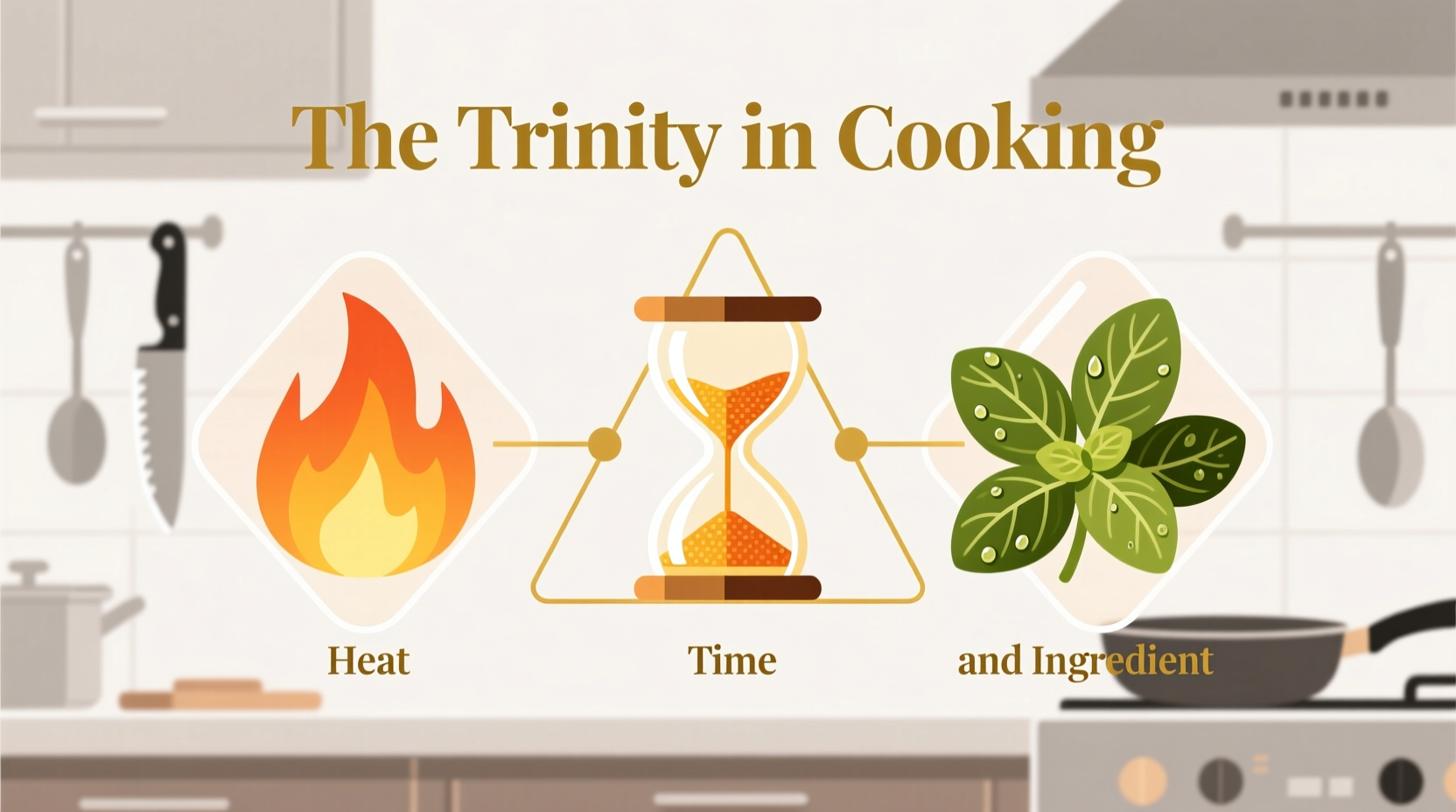Ever wondered what gives authentic Southern Louisiana dishes their unmistakable depth and complexity? The secret lies in a simple yet powerful trio of ingredients known as the trinity. As a culinary historian specializing in regional American cooking traditions, I've traced how this humble combination has shaped the flavor landscape of the Gulf Coast for generations. Understanding the trinity isn't just about knowing three ingredients—it's about grasping a fundamental cooking principle that transforms ordinary meals into extraordinary culinary experiences.
Breaking Down the Culinary Trinity: Ingredients and Ratios
At its core, the trinity consists of three humble vegetables that work in perfect harmony:
- Onions (yellow or white) - providing sweetness and depth
- Celery - contributing earthy, herbal notes
- Green bell peppers - adding brightness and subtle bitterness
The traditional ratio follows a precise 2:1:1 formula—two parts onions to one part celery and one part green bell pepper. This specific balance ensures no single flavor dominates, creating a harmonious foundation that supports other ingredients without overpowering them. Professional chefs consistently emphasize that deviating from this ratio alters the fundamental character of dishes relying on the trinity.
| Component | Flavor Profile | Traditional Ratio | Preparation Method |
|---|---|---|---|
| Onions | Sweet, pungent, aromatic | 2 parts | Finely diced |
| Celery | Earthy, herbal, slightly bitter | 1 part | Finely diced |
| Green Bell Peppers | Bright, grassy, subtle bitterness | 1 part | Finely diced |
Historical Evolution: From French Kitchens to Louisiana Bayous
The trinity's story begins with French settlers who brought their culinary traditions to colonial Louisiana. The French mirepoix—a combination of onions, carrots, and celery—served as the original foundation. However, as these techniques adapted to the New World environment, a crucial transformation occurred.
Carrots proved difficult to grow in Louisiana's humid climate, while bell peppers thrived in the region's fertile soil. By the early 19th century, resourceful cooks had substituted bell peppers for carrots, creating what would become known as the trinity. This adaptation wasn't merely practical—it fundamentally reshaped the flavor profile of regional cooking, giving birth to the distinctive taste we now associate with authentic Cajun and Creole cuisine.
According to culinary historians at the Southern Foodways Alliance, the term "trinity" gained widespread usage in the mid-20th century as Louisiana's culinary identity became more formally documented. The name likely reflects both the three components and the cultural significance of the number three in Catholic traditions prevalent among early Louisiana settlers.

Trinity vs. Similar Culinary Foundations: Understanding the Differences
While many global cuisines use aromatic vegetable bases, the trinity has distinct characteristics that set it apart from similar preparations. Understanding these differences helps home cooks select the appropriate foundation for various dishes.
The French mirepoix (onions, carrots, celery) creates a sweeter, earthier base ideal for French stews and sauces. Italy's soffritto (onions, carrots, celery with olive oil) forms the backbone of many pasta sauces. Spain's sofrito (onions, garlic, tomatoes) delivers a brighter, more acidic foundation for paella and other Mediterranean dishes.
What makes the trinity unique is its specific vegetable combination and ratio, plus the cooking technique. Unlike mirepoix which often includes carrots, the trinity's bell peppers provide a distinctive grassy note that defines Louisiana cooking. The traditional preparation involves sweating the vegetables slowly in oil or butter until translucent but not browned—a technique crucial for developing the proper flavor base without caramelization.
Practical Applications: Using the Trinity in Your Kitchen
Mastering the trinity transforms your approach to Southern cooking. Here's how to incorporate it effectively:
- Proper preparation: Dice all components to uniform size (about 1/4 inch) for even cooking
- Cooking technique: Start with oil or butter in a cold pan, then add the trinity and cook over medium-low heat
- Cooking time: Allow 15-20 minutes for the vegetables to become translucent without browning
- Layering flavors: Add garlic after the trinity has softened (about 5 minutes before finishing)
For authentic gumbo, the trinity should cook until completely soft but not colored—this creates the proper flavor foundation without the sweetness that browning would introduce. In jambalaya, some cooks prefer a slightly caramelized trinity for added complexity, demonstrating how small variations create different regional interpretations.
When preparing the trinity, remember that quality ingredients matter. Fresh, firm vegetables with vibrant colors yield the best results. Many Louisiana chefs recommend using Vidalia onions for their sweetness, though traditional yellow onions work perfectly well. The bell peppers should be bright green and crisp, never soft or discolored.
Avoiding Common Trinity Mistakes
Even experienced cooks sometimes misstep when working with the trinity. Here are the most frequent errors and how to avoid them:
- Incorrect ratios: Using equal parts of all three ingredients creates an unbalanced flavor. Stick to the 2:1:1 ratio for authentic results
- Improper dicing: Uneven pieces cook at different rates, leading to some ingredients burning while others remain raw
- Too-high heat: Rushing the cooking process causes browning rather than the desired translucent softening
- Substituting red or yellow peppers: While sometimes used in modern variations, green bell peppers are traditional and provide the correct flavor profile
- Skipping the sweating process: Properly cooking the trinity takes time—don't rush this foundational step
For those new to Louisiana cooking, I recommend preparing a basic trinity and storing it in the refrigerator for up to five days or freezing it for longer storage. Many home cooks find it helpful to prepare large batches when bell peppers are in season, then freeze portions for year-round use. Just remember to thaw frozen trinity completely before cooking to ensure even results.
When the Trinity Isn't Appropriate: Understanding Culinary Boundaries
While versatile, the trinity isn't suitable for every dish. Understanding its limitations helps you make better culinary decisions:
- French or European dishes: Stick with mirepoix for authentic French, Italian, or Spanish recipes
- Asian cuisine: The trinity's flavor profile clashes with traditional Asian aromatic bases like ginger, garlic, and scallions
- Sweet applications: The trinity works exclusively in savory dishes, not desserts or sweet preparations
- Quick-cooking dishes: For stir-fries or other fast-cooked meals, the trinity requires too much preparation time
Some modern chefs experiment with variations, such as adding garlic to create a "holy trinity plus one," but purists maintain that the traditional three-ingredient combination defines authentic Louisiana cooking. When adapting recipes, consider whether the dish's cultural origins align with the trinity's flavor profile before incorporating it.
Frequently Asked Questions About the Culinary Trinity
Can I substitute red or yellow bell peppers for green in the trinity?
While some modern variations use colored bell peppers, traditional Louisiana cooking specifically calls for green bell peppers. Green peppers have a more bitter, grassy flavor that defines authentic Cajun and Creole dishes. Red and yellow peppers are sweeter and will significantly alter the flavor profile of traditional recipes like gumbo and jambalaya.
Why is it called the trinity in cooking?
The name "trinity" refers to both the three essential ingredients (onions, celery, and green bell peppers) and likely has cultural connections to the importance of the number three in Catholic traditions prevalent among early Louisiana settlers. The term gained widespread usage in the mid-20th century as Louisiana's culinary identity became more formally documented by food historians and chefs.
What's the difference between the trinity and mirepoix?
The primary difference lies in the ingredients: mirepoix (French) uses onions, carrots, and celery, while the trinity (Cajun/Creole) uses onions, celery, and green bell peppers. Mirepoix creates a sweeter, earthier base ideal for French cuisine, while the trinity's bell peppers provide a distinctive grassy note that defines Louisiana cooking. The trinity also follows a specific 2:1:1 ratio of onions to celery to bell peppers.
Can I make the trinity ahead of time?
Yes, you can prepare the trinity ahead of time. Dice the vegetables and store them together in an airtight container in the refrigerator for up to five days. For longer storage, you can cook the trinity until translucent, then freeze it in portion-sized containers for up to three months. Just remember to thaw frozen trinity completely before using it in recipes for best results.
Does the trinity work in vegetarian or vegan cooking?
Absolutely. The trinity is naturally vegetarian and vegan, making it an excellent flavor foundation for plant-based Louisiana dishes. Many traditional gumbo recipes start with the trinity before adding vegetable stock and other plant-based ingredients. The trinity's versatility shines in vegetarian cooking, providing the same depth of flavor it does in meat-based dishes.











 浙公网安备
33010002000092号
浙公网安备
33010002000092号 浙B2-20120091-4
浙B2-20120091-4